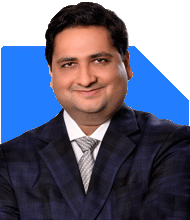Should I Make Changes to My Aggressive Mutual Fund Portfolio?
Ramalingam Kalirajan |10893 Answers |Ask -Follow
Mutual Funds, Financial Planning Expert - Answered on Jan 09, 2025
He has an MBA in finance from the University of Madras and is a certified financial planner.
He is the director and chief financial planner at Holistic Investment, a Chennai-based firm that offers financial planning and wealth management advice.... more

Hi Ulhas, i am 44 years of age and have been investing in MF since Feb 2021, presently I am investing a monthly SIP of 5.5 Lakhs in the following 11 funds each with a monthly SIP of 50 K in direct funds, please check whether my portfolio requires any changes. I am an aggressive investor with more than 10-15 years of long-term horizon. 1. parag parakh flexi cap fund. 2. Mirae Large & Mid Cap fund. 3. Axis growth opportunities fund. 4. SBI Multi Cap Fund. 5. Mirae Mid Cap fund. 6. Quant Active Fund. 7. Canara Robeco Small Cap fund. 8. Tata Small Cap Fund. 9. HDFC Multicap fund. 10. Edelweiss Midcap Fund. 11. Kotak Multicap fund.
Strengths of Your Current Portfolio
Well-Diversified Across Categories: Your funds span large-cap, mid-cap, small-cap, and flexi-cap categories.
Aligned with Aggressive Strategy: The portfolio leans towards mid-cap and small-cap funds. These suit long-term aggressive investors.
Consistent Contributions: High SIP commitment ensures disciplined wealth creation over time.
Areas of Concern
Over-Diversification: Investing in 11 funds dilutes potential returns. Similar categories may overlap.
Direct Funds Approach: Direct plans lack professional guidance for portfolio review and rebalancing.
Small-Cap Heavy Allocation: Multiple small-cap funds increase risk in volatile markets.
Multiple Multicap Funds: Holding three multicap funds may result in duplication of stocks.
Suggestions for Portfolio Optimisation
Limit the Number of Funds
Reduce the number of funds to 5-7. This avoids over-diversification.
Retain one strong performer from each category: large-cap, mid-cap, small-cap, flexi-cap, and multicap.
Avoid Category Duplication
Retain only one fund each in small-cap, mid-cap, and multicap categories.
Choose funds with consistent past performance and fund house credibility.
Focus on Actively Managed Funds Through MFD
Direct funds lack professional advice.
Investing through an MFD with a Certified Financial Planner ensures expert guidance.
MFDs monitor market conditions and align your portfolio for optimal returns.
Reassess Risk Allocation
Small-cap funds should be limited to 10-15% of your portfolio.
Mid-cap funds can constitute 25-30% for higher growth potential.
Allocate 25-30% to large-cap or flexi-cap funds for stability.
Periodic Review and Rebalancing
Review your portfolio every six months or annually.
Rebalance to maintain your desired asset allocation.
Track fund performance and exit underperformers promptly.
Tax Implications to Consider
Long-term capital gains above Rs. 1.25 lakh attract 12.5% tax.
Short-term gains are taxed at 20%.
Diversifying across equity and hybrid funds can optimise tax outflow.
Benefits of Reduced Fund Count
Simplified portfolio management.
Improved tracking of individual fund performance.
Higher potential for compounding due to concentrated allocation.
Recommended Allocation for Aggressive Investors
Large-Cap/Flexi-Cap Funds: Stability with market participation.
Mid-Cap Funds: Balance between risk and growth.
Small-Cap Funds: High-risk, high-reward potential.
Multicap Funds: Flexible allocation across market capitalisations.
Final Insights
Your portfolio reflects strong financial discipline and long-term vision. However, over-diversification dilutes growth. Streamline your funds for focused performance. Professional guidance ensures optimal fund selection and timely rebalancing. Stick to your SIPs to achieve your financial goals.
Best Regards,
K. Ramalingam, MBA, CFP,
Chief Financial Planner,
www.holisticinvestment.in
https://www.youtube.com/@HolisticInvestment
You may like to see similar questions and answers below
Hardik Parikh | Answer |Ask -Follow
Tax, Mutual Fund Expert - Answered on Apr 20, 2023
Ramalingam Kalirajan |10893 Answers |Ask -Follow
Mutual Funds, Financial Planning Expert - Answered on Apr 18, 2024
Ramalingam Kalirajan |10893 Answers |Ask -Follow
Mutual Funds, Financial Planning Expert - Answered on Oct 07, 2024
Ramalingam Kalirajan |10893 Answers |Ask -Follow
Mutual Funds, Financial Planning Expert - Answered on Dec 15, 2025
Ramalingam Kalirajan |10893 Answers |Ask -Follow
Mutual Funds, Financial Planning Expert - Answered on Dec 15, 2025
Radheshyam Zanwar |6746 Answers |Ask -Follow
MHT-CET, IIT-JEE, NEET-UG Expert - Answered on Dec 15, 2025
Ramalingam Kalirajan |10893 Answers |Ask -Follow
Mutual Funds, Financial Planning Expert - Answered on Dec 15, 2025
Ramalingam Kalirajan |10893 Answers |Ask -Follow
Mutual Funds, Financial Planning Expert - Answered on Dec 15, 2025
Ramalingam Kalirajan |10893 Answers |Ask -Follow
Mutual Funds, Financial Planning Expert - Answered on Dec 15, 2025
Samraat Jadhav |2508 Answers |Ask -Follow
Stock Market Expert - Answered on Dec 15, 2025
Ramalingam Kalirajan |10893 Answers |Ask -Follow
Mutual Funds, Financial Planning Expert - Answered on Dec 15, 2025
Reetika Sharma |425 Answers |Ask -Follow
Financial Planner, MF and Insurance Expert - Answered on Dec 15, 2025
Radheshyam Zanwar |6746 Answers |Ask -Follow
MHT-CET, IIT-JEE, NEET-UG Expert - Answered on Dec 15, 2025






















